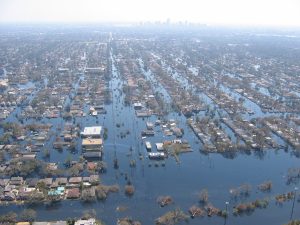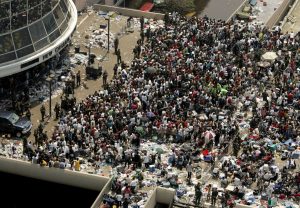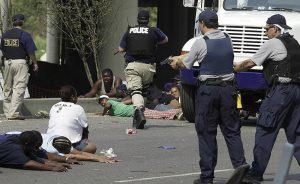Re-Posted – Project Katrina

The below was a plan drawn up during the Katrina crisis, based largely on principles derived for Project Niger earlier: using the web as a communication infrastructure, achieving leveraged effects by enabling the lay person to contribute cycles and by maximizing efficiencies for those cycles.
Hurricane Katrina was one of the deadliest hurricanes ever to hit the United States. An estimated 1,833 people died in the hurricane and the flooding that followed in late August 2005, and millions of others were left homeless along the Gulf Coast and in New Orleans.
As Katrina made landfall, its front-right quadrant, which held the strongest winds, slammed into Gulfport and Biloxi, Mississippi, devastating both cities. A large storm surge of up to 28 feet devastated coastal areas across southeastern Louisiana and coastal Mississippi. Katrina’s highest sustained winds were at 174mph. The storm was 400 miles wide.
Later, a select bipartisan committee of the U.S. House of Representatives investigating the preparation, response and aftermath of the storm cited failures at all levels of government. The committee’s final report was titled “A Failure of Initiative.”

Ten years later, the region was still recovering from Katrina. While many of the tourist areas such as the French Quarter have recovered, there are still neighborhoods just a short ride from the city that are just gone.
In the chaotic days after Hurricane Katrina, an order circulated among New Orleans police authorizing officers to shoot looters, according to present and former members of the department.
It’s not clear how broadly the order was communicated. Some officers who heard it say they refused to carry it out. Others say they understood it as a fundamental change in the standards on deadly force, which allow police to fire only to protect themselves or others from what appears to be an imminent physical threat

Here’s the earlier post:
The Katrina relief effort has shown that the inefficiencies that are commonly found in government should not be counted out when planning for disaster relief.
The following is a bulleted list of items that we feel would most effectively compose an infrastructure for dealing with disaster relief in general.
Our approach will be to develop internet programs to address most of the needs below as we advance through the different stages of disaster relief.
The 1st stages of relief should focus primarily on personal security — evacuation, food, water
- Evacuees need to know what services are available for evacuation
- Helping organizations need to know what evacuation requirements have not been met
- Helping organizations need to know what infrastructure services remain at given perimeters
- Infrastructure providers need to know where to report their status and when their services are no longer needed at given perimeters
The 2nd stages of relief should focus on organizing related information to optimize efficiency
- Evacuation groups need to know where to report the people they’ve found
- Everyone needs to know who is tracking the status of evacuees and victims
- Everyone needs to know where to go to find out who is doing what
- Everyone needs to know where to go to find out what is needed, or who is reporting what is needed
- What is needed from those giving money
- What is needed from those contributing their services
- Where they can go to register their skills and monetary/time-frame requirements
- Some might be able to donate 100% of their time with no pay
- Others might be able to donate 50%, 20%, 10%, or less of their time with reduced pay for 1 or 2 weeks ( some at 20% level, some at 50% level ? ) or 1 month, 3 months, 6 months, or a year
- Others might be interested in changing careers or jobs to help with disaster relief
- Helping organizations need to know what infrastructure is available for them
- What gas is available for helping orgs.
- What food and water is available for helping orgs.
- What motel and meeting services are available for helping orgs.
- What communication services are available within different perimeters of the disaster
- What cost-offset resources are available for helping organizations
- Governments, helping organizations, and evacuees need to know where to report activities that need to be handled better in
similar future events- Root cause analysis needs to be done, and optimal improvements made to future planning
The 3rd stages should include rebuilding damaged and destroyed infrastructure, and relocating evacuees who desire returning
- Evacuees need to know when their residences or businesses have been determined to be unrepairable or ready for re-use
- Evacuees need to know what jobs are available in their original community, and what jobs are being made especially available for evacuees in their new communities
- Evacuees need continued access to
- Food, shelter, clothing
- Counseling
- Emergency cash
- Re-development businesses need to know
- Where their services are needed
- Where they can go to recruit evacuees with desired skillsets
- Where they can go to access funding available for re-development
- Where they can go to report services they need
- Where they can go to report investment opportunities related to re-development
- Other people need to know
- What related funds there are to contribute to
- What re-development-related jobs are available
- What is current status of federal funds availability for various needs
- What investment opportunities exist in support of redevelopment
https://www.livescience.com/22522-hurricane-katrina-facts.html
https://www.ajc.com/news/national/how-strong-was-hurricane-katrina/ShOQySpBjYfZOfmWzPr7sO/
After Katrina, New Orleans cops were told they could shoot looters


Great ideas! You should forward this information to Red Cross. I made a similar plan but for a smaller scale when I was at Brighton Gardens of Columbia. After 9/11 I was charged with coming up with a plan to account for all the residents there. I called it The Disaster Plan. Great minds think alike!
Where’s that smile emoji? Nice! Lol